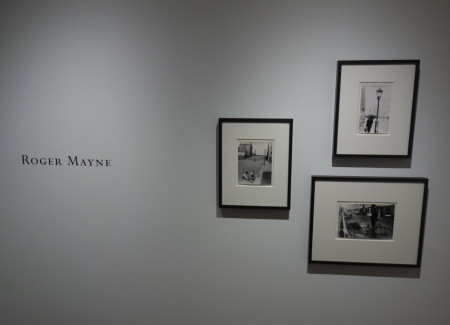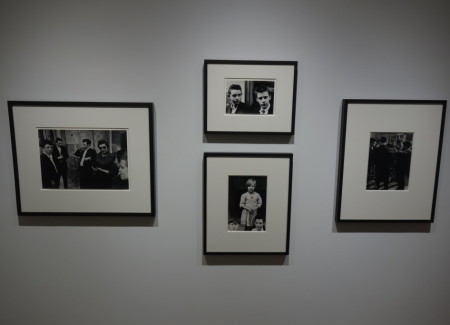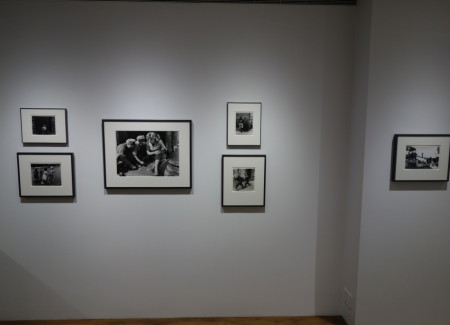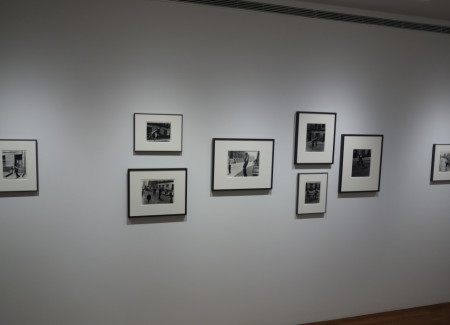JTF (just the facts): A total of 52 black and white photographs, framed in black and matted, and hung against white walls in the main gallery space. All of the works are vintage gelatin silver prints, made between 1954 and 1960, with one print from 1972. No physical dimensions or edition information was provided on the checklist. (Installation shots below.)
Comments/Context: Roger Mayne’s photographs of 1950s London are an observant societal study of a city in transition. Brimming with the collective human grubbiness of post-war life, they insightfully capture a time and place in Britain where children amused themselves in the streets and housing blocks were bombed out hulks or marked for redevelopment. Mayne settled into these changing neighborhoods, watching with patient eyes as improvised games of cricket, soccer, and other ball games provided entertainment and release for kids of all ages, and made pictures that have stood the test of time as engaged cultural documentation.
When we see a gallery show of greatest hits or carefully curated best images by a photographer, we get a sense for the tips of the waves of his or her career, the standout images providing handy measuring sticks that we then use to compare with contemporaries and others of like mind or approach. But what’s intriguing about this unorthodox exhibit is that it goes far beyond Mayne’s most familiar images and notable highlights, and tries to show us something deeper about his picture-taking process, or better yet, the workings of his eye.
While contact sheets provide a record of every shutter click made by a photographer at a particular place and time, they are often overrun by misfires, minute variants, and transitional shots – we’ve all paged through sheets where only a single frame is circled in grease pencil. But what this show does is pare away those less informative images and gathers together the pictures that made the cut from a single day of shooting or work at a single location, where every image on view here met Mayne’s standards and could stand on its own, even if it happened to take place just a few moments after another winner. These prints have then been hung together in clusters, where half a dozen or more final images from a session allow us to see Mayne’s mind at work, without the distracting visual clutter of the throwaways.
A selection of images of kids playing on a rubble strewn bomb site allow us to watch Mayne repeatedly shift and turn. The most famous of the images from this sequence shows a girl in a long coat and sensible shoes balanced on an old iron bedframe, tossing a ball into the air against a backdrop of graffiti – as decisive moments go, it’s an excellent one. But as we then look at the other images from that same series, before and after the action of that particular image, Mayne was already building layered, up and down compositions long before the ball took flight. Boys in coats and short pants tumble over the broken brick debris, turning a long bent pipe into a kind of ceremonial trophy like an elephant tusk and lifting an old washbasin into the air like a test of strength. The pile of rubble provides plenty of opportunities for teetering and climbing at different heights, and the kids stand and wobble around with outstretched arms in improvised games, the ball always at the ready. And what emerges from the group of pictures is a broader vision of the children as busy creators, and of the subtle balance of interaction going on between them as they show off for each other.
A second cluster of pictures follows a single boy (named Keith) as he plays in a game of street cricket. We see him bat, and pitch, and move with intent anticipation, ultimately emerging with triumphant arms raised victory. Framed against the patterned cobblestones, his scuffed knees and easy going confidence feel universal, Mayne’s images capturing the bounce in his step and the energy in his attitude. Two other groups capture games of street soccer (in Southam Street and Brindley Road), with a wide variety of ages and abilities. In these images, Mayne steps back several paces, allowing the movement of multiple players (and bystanders) to coalesce using the angles and lines of the street, the gutter, and the surrounding buildings as framing devices. Bodies become ongoing compositional studies of movement, from a goaltender’s skyward jump to the evasive dark silhouettes of jostling players.
Whether Mayne was tracking suited businessmen, rebellious teenagers, or young women on their lunch break, these clusters of pictures show a photographer who settled in for longer engagements, taking his time to find the combinations of people, streets, and activities that would resolve into something memorable. These images tell the story of Mayne as a steady and methodical photographer rather than a quick shot gunslinger, an artist who knew that if he kept looking long enough, the elements of a great picture were there to be discovered, even in the most humble and unassuming circumstances of unattended children making up games in the downtrodden streets. His pictures reflect a genuine interest in people, and in their tiny moments of struggle and glory.
Collector’s POV: The prints in this show are priced between $4500 and $8500 (generally based on size), with some works already sold. Mayne’s work has only been intermittently available in the secondary markets in the past decade, with prices generally ranging between $1000 and $4000.














